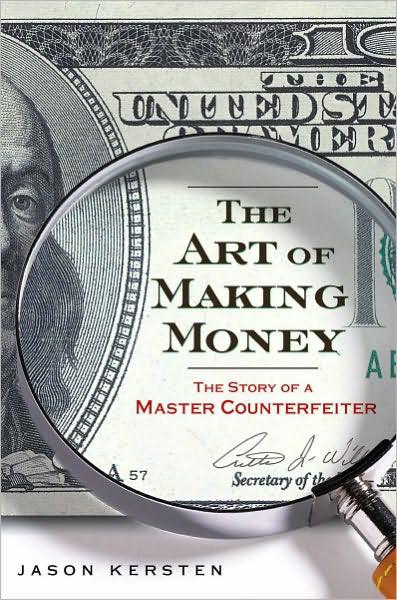
The Art of Making Money
The Story of a Master Counterfeiter
کتاب های مرتبط
- اطلاعات
- نقد و بررسی
- دیدگاه کاربران
نقد و بررسی

Starred review from April 20, 2009
A young smalltime crook with a meticulous eye for artistic detail and an addiction to the thrill of crime crafts millions in high-quality phony bills in Kersten’s account of counterfeiter Art Williams Jr. Born in 1972 and abandoned by his father to poverty, the gritty gangs of Chicago and a mentally ill mother, Williams slid into an underworld of theft and violence before a bohemian money crafter introduced him to counterfeiting. With swagger, ingenuity and a devoted wife, Williams produced millions of dollars’ worth of uncannily accurate bills for 14 years, till the Secret Service caught up with him. As Kersten narrates this story, he ably weaves the minuscule details of currency security with colorful portraits of underworld characters like a Chinese mob leader known as the Horse and tales of giddy shopping sprees fueled by sex, fake bills, even mischievous masquerades as priests. Illustrating Williams not only as a delinquent genius but a sensitive young man seeking paternal love and aesthetic validation, Kersten (who first told Williams’s story in Rolling Stone
) configures a rollicking and captivating look into a compelling criminal mind.

April 15, 2009
Expanding on his Rolling Stone article, first-time author Kersten tenders a lawbreaker's script about fake money and an alternative lifestyle, told largely from the viewpoint of the fascinating perp.
Engaging and accomplished counterfeiter Art Williams had a truly rotten childhood, according to the memories he shared with the author. After considerable bad behavior, Dad skipped out, leaving the kids with certifiably crazy Mom. Gangs dictated life and death on the gritty streets of Chicago's worst neighborhood. Yet there Williams was mentored by benevolent Pete"DaVinci," a clever printer of bank notes. One day, his teacher was gone, and the young student, with native pluck and instinctive smarts, manfully clawed his way to the top of the counterfeiting heap. Ironically, he only got into trouble with the law after a breakup with a girlfriend led him to sell off his printing equipment, move to Texas and take up robbery. Nabbed in a jewelry heist, he did six years in the Texas penal system and emerged in 1999 swearing he'd stick to bad bills. But the familiar old currency was being supplanted by the"New Note," whose enhanced paper, watermarks, security strips and microprinting were nearly impossible to replicate. Not for the inventive and proficient Williams, who produced a creditable bogus hundred using glues, sprays, ink, paper, press, camera, scanner and laptop. He wholesaled his product at 30 cents on the dollar, but it was more exciting to pass it on road trips with family and friends. It's estimated that Williams stimulated his own economy with some $10 million in counterfeit before he was nabbed. His downfall resulted from family problems, especially misplaced filial consideration. Where is our hero now? Just where you would expect, considering that he's a recidivist.
An absorbed reporter grippingly relays the story of a rare trade and the troubled family relations of a talented grifter.
(COPYRIGHT (2009) KIRKUS REVIEWS/NIELSEN BUSINESS MEDIA, INC. ALL RIGHTS RESERVED.)

June 15, 2009
An intelligent, likable boy raised by a mentally troubled mother (his father was absent), master counterfeiter Art Williams drifted into involvement with street gangs at an early age in Chicago. Eventually, a counterfeiter named Pete DaVinci showed Williams the tricks of the trade, from producing to distributing the bills. He soon ventured out on his own, selling bills to Chicago's organized crime gangs, who used the money in a variety of illegal operations. After a stay in a Texas prison, Williams returned to counterfeiting, using computer desktop publishing software and printers to produce bills. He even managed to copy the new $100 bills that incorporated many features designed to deter counterfeiters. At the same time, he reconnected with his father, then living in Alaska, but was soon betrayed by a family member to the U.S. Secret Service. VERDICT Journalist Kersten's absorbing account reads like crime fiction, offering an understanding of modern counterfeiting that will appeal to readers of that genre as well as those who like true crime. [See Prepub Alert, "LJ" 2/1/09.]Stephen L. Hupp, West Virginia Univ., Parkersburg
Copyright 2009 Library Journal, LLC Used with permission.

June 1, 2009
No sooner was money created thanpeople began dreaming of ways to counterfeit it, including the philosopher Diogenes. Journalist Kersten chronicles the life and crimes of Art Williams, whose 14-year counterfeiting spree generated an estimated $10 million in phony money. Williams family plunged from middle-class respectability to poverty when his father abandoned the family, leaving three children in the care of a bipolar mother. Growing up in the projects in Chicago, Williams was eventually recruited into the arcane world of counterfeiting, following the legacy of close ties and intimate knowledge that marks this particular crime. After spending three years in prison in Texas for burglary, Williams emerged to learn of the Super Note, the Treasury Departments latest effort to foil counterfeiters. It was a challenge he couldnt resist, printing hundred-dollar bills, distributing them through criminal networks, and taking his own cross-country spending sprees to convert the fake money, until he was undone by a burning desire to reunite with his father. Kersten reveals a world of cutthroat criminals and criminal ingenuity in this look at one mans wayward career.(Reprinted with permission of Booklist, copyright 2009, American Library Association.)

























دیدگاه کاربران